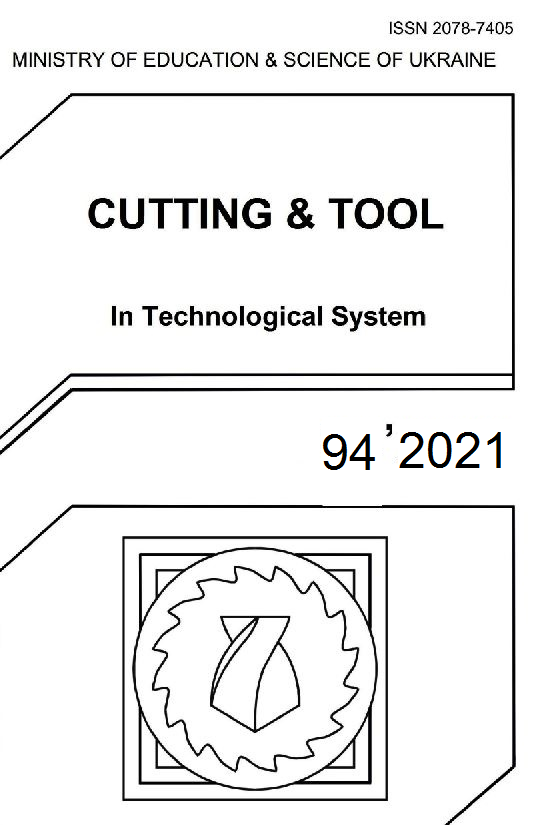TRIBOLOGY AND TOPOGRAPHY OF HARD MACHINED SURFACES
DOI:
https://doi.org/10.20998/2078-7405.2021.94.06Keywords:
hard turning, in-feed grinding, 3D surface roughness, tribologyAbstract
In machining automotive industrial parts by hard machining procedures, the topographic characteristics of high accuracy surfaces have high importance. In this paper 2D and 3D surface roughness features of gear bores machined by hard turning and grinding are demonstrated. The 3D roughness parameters, which are considered as more exact than the 2D parameters, were compared to the 2D ones, which are used more widely in industrial practice. The analyzed machining procedure versions were ranked based on the topographic parameters determining the tribological (wear and oil-retention capability) characteristics of the different surfaces.
References
Karpuschewski, B., Kundrak, J., Emmer, T., Borysenko, D.: A new strategy in face milling-inverse cutting technology, Solid State Phenomena, No. 261, 2017, pp.331–338
Ferencsik, V., Gal, V.: FE Investigation of Surface Burnishing Technology, Cutting & Tools in Technological System, No. 93, 2020, pp.3–8
Kundrak, J., Gyani, K., Felho, C., Deszpoth, I.: The effect of the shape of chip cross section on cutting force and roughness when increasing feed in face milling, Manufacturing Technology, Vol. 17, No. 3, 2017, pp.335–342
Sztankovics, I., Kundrak, J.: The characteristic parameters of the twist structure on cylindrical surfaces machined by turning procedures, Applied Mechanics and Materials, No. 693, 2014, pp. 418–423
Kundrak, J.,
Sztankovics, I., Gyani, K.: Analysis of the Theoretical Values of Several Characteristic Parameters of Surface Topography in Rotational Turning, World Academy of Science Engineering and Technology, Vol. 8, No. 5, 2014, pp. 907–912
Kundrak, J. (1996): The Scientific Principles of Increasing the Effectiveness of Inner Surfaces' Cutting with CBN Tools, Dissertation, p.368
Kundrak, J., Markopoulos, A.P., Makkai, T., Deszpoth, I., Nagy, A.: Analysis of the effect of feed on chip size ratio and cutting forces in face milling for various cutting speeds, Manufacturing Technology, Vol. 18, No. 3, 2018, pp.431–438
Sukaylo, V.A., Kaldos, A., Krukovsky, G., Lierath, F., Emmer, T., Pieper, H.J., Kundrak, J., Bana, V.: Development and verification of a computer model for thermal distortions in hard turning, Journal of Materials Processing Technology, Vol. 155, No. 1-3, 2004, pp.1821–1827
Nagy, A.: Influence of Measurement Settings on Areal Roughness with Confocal Chromatic Sensor on Face-Milled Surface, Cutting & Tools in Technological System, No. 93, 2020, pp.65–75
Kundrak, J., Varga, G., Deszpoth, I., Molnar, V.: Some aspects of the hard machining of bore holes, Applied Mechanics and Materials, No. 309, 2013, pp.126–132
Kundrak, J., Varga, G.: Possibility of reducing environmental load in hard machining, Key Engineering Materials, No. 496, 2011, pp.205–210
Kundrak, J., Mamalis, A.G., Markopoulos, A.: Finishing of hardened boreholes: Grinding or hard cutting?, Materials and Manufacturing Processes, Vol. 19, No. 6, 2004, pp. 979–993
Kundrak, J.: Alternative machining procedures of hardened steels, Manufacturing technology, Vol. 11, No. 11, 2011, pp. 32–39
El-Tayeb, N.S.M, Low, K.O., Brevern, P.V.: On the surface and tribological characteristics of burnished cylindrical Al-6061, Tribology International, Vol. 42, 2009, pp. 320–326
Whittaker, R.K., Hothi, H.S., Eskelinen, A., Blunn, G.W., Skinner, J.A., Hart, A.J.: Variation in Taper Surface Roughness for a Single Design Effects the Wear Rate in Total Hip Arthroplasty, Journal of Orthopaedic Research, Vol. 35, 2017, pp.1784–1792
Gadelmawlaa, E.S., Kourab, M.M., Maksoucf, T.M.A., Elewaa, I.M., Solimand, H.H.: Roughness parameters, Journal of Materials Processing Technology, Vol. 123, 2002, pp.133–145
ISO 25178-2:2012 Geometrical product specifications (GPS) - Surface texture: Areal - Part 2: Terms, definitions and surface texture parameters. 2012
Stout, K., Blunt, L.: Three-dimensional Surface, Topography. 2 ed. London: Penton Press, 2000
Kovacs, Z., Viharos, Z.J., Kodacsy, J.: The effects of machining strategies of magnetic assisted roller burnishing on the resulted surface structure, Materials Science and Engineering, No. 448, 2018, nr.012002
Whitehouse, D.J.: Handbook of Surface Metrology, Institute of Physics Bristol, UK, 1994
Struzikiewicz, G., Sioma, A.: Evaluation of Surface Roughness and Defect Formation after the Machining of Sintered Aluminum Alloy AlSi10Mg, Materials, Vol. 13, No. 7, 2020
Deltombe, R., Kubiak, K.J., Bigerelle, M.: How to Select the Most Relevant 3D Roughness Parameters of a Surface?, Scanning, Vol. 36, No. 1, 2014, pp.150–160
Downloads
Published
Issue
Section
License
Copyright Notice
Authors who publish with this Collection agree to the following terms:
1. Authors retain copyright and grant the Collection right of first publication with the work simultaneously licensed under a Creative Commons Attribution License that allows others to share the work with an acknowledgement of the work's authorship and initial publication in this Collection.
2. Authors are able to enter into separate, additional contractual arrangements for the non-exclusive distribution of the Collection's published version of the work (e.g., post it to an institutional repository or publish it in a book), with an acknowledgement of its initial publication in this Collection.
3. Authors are permitted and encouraged to post their work online (e.g., in institutional repositories or on their website) prior to and during the submission process, as it can lead to productive exchanges, as well as earlier and greater citation of published work.

